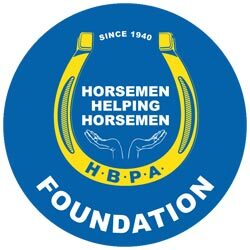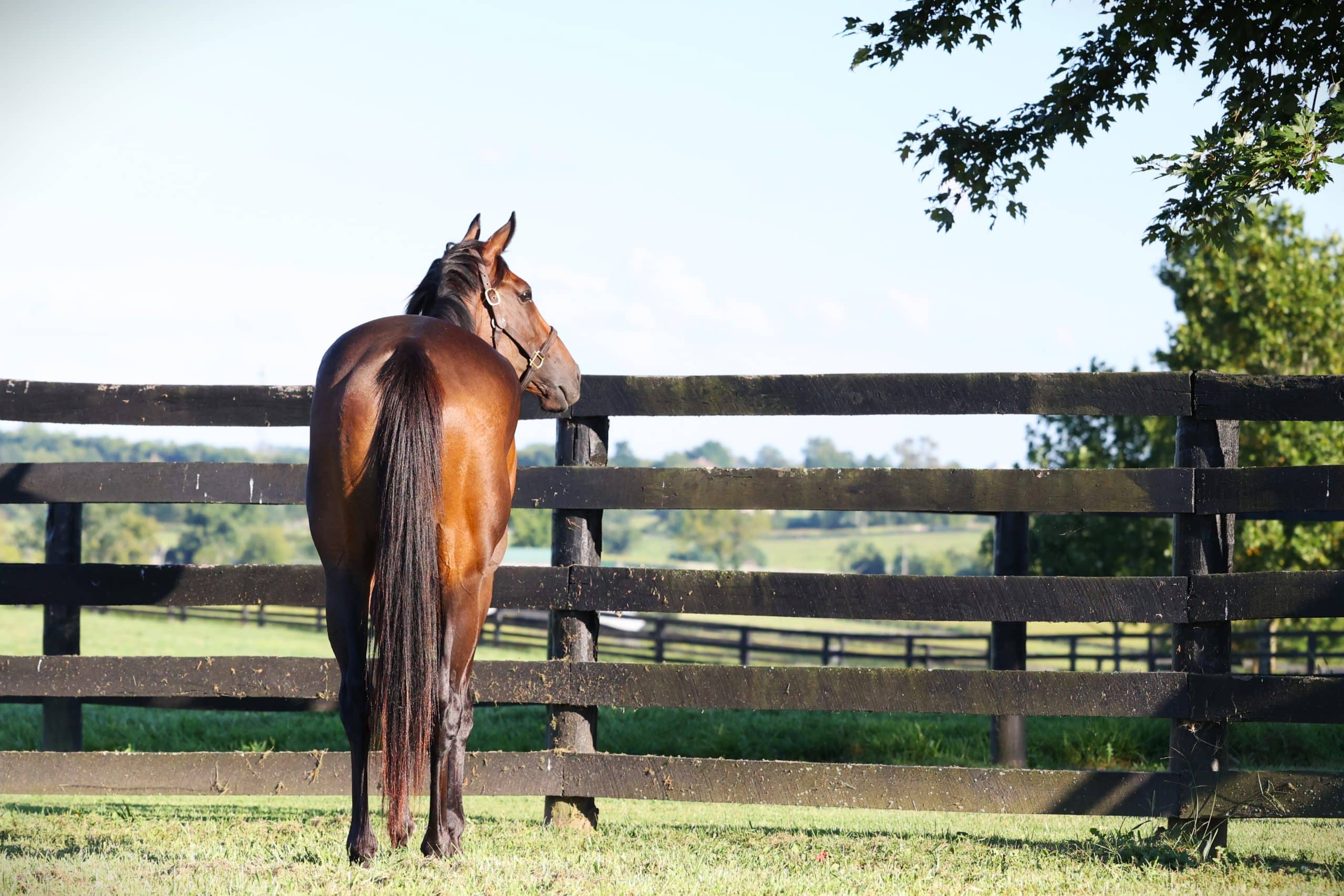
Fiddle gets a few days of turnout and hacking on the farm between races. Courtesy Jen Roytz
Fiddle, a 2-year-old filly just beginning her racing career in Kentucky, takes her job so seriously that following a race she needs a mini-vacation. Fortunately, co-owner Jen Roytz and trainer Anna Meah know exactly what to do.
“We bring her home after her races for a few days of paddock turnout and hacking around at the farm,” says Roytz.
Versions of this scenario play out at racetracks across the country. When horses need a mental or physical break from their racetrack routine, many owners and trainers send them to a nearby farm for a little R & R. It often does wonders for the animals, refreshing them and giving them renewed energy for their next race.
Brickyard Ride (Clubhouse Ride — Brickyard Helen, Southern Image), a brilliant sprinter in California, spent a few months at a nearby farm in late 2021. When he returned to the races at Santa Anita this past winter, he reeled off four consecutive stakes victories — one a month from January through April.
During the 1960s Kelso won five consecutive Horse of the Year titles. Between racing campaigns he sometimes spent time at owner Allaire du Pont’s Woodstock Farm, in Maryland, where he ultimately lived until his death at age 26. Kelso’s winter breaks undoubtedly contributed to his longevity — he ran in 63 races and earned nearly $2 million.
Racehorse vacations work much like downtime between sport horse show seasons. Whatever a horse participates in, be it eventing, dressage or reining, after a long year of hauling to shows, that animal can thrive with a little break.
“It’s kind of like a kid coming home from college,” Roytz says. “School can be a bit overwhelming for a young adult with midterms, finals and so many activities and commitments. It’s a rigorous schedule compared to what they’ve known in the past. Sometimes it helps for them to just come home for a weekend where everything is familiar and calmer, and they head back to school refreshed and ready for what lies ahead.”
Roytz brings an excellent perspective to this routine. She and her husband, veterinarian Stuart Brown, DVM, own and operate Brownstead Farm, in Central Kentucky, where they raise, sell and race Thoroughbreds, as well as retrain them for second careers. Roytz served six years on the Retired Racehorse Project’s board and was its executive director from 2018 to 2021.
For Roytz, bringing horses home when necessary during their racing careers is just part of their journey from early breaking and training, through their initial jobs as racehorses and on to whatever discipline they demonstrate a talent for as a second career.
“When they come home, I ride them more like a sport horse than a racehorse, and it makes the transition later on when they retire that much easier,” Roytz says. “They already know simple lateral work, trot and canter poles, they hack through fields and over natural obstacles. That’s great for their heads because it’s so much different from the track.”
Horses, like humans, get bored doing the same thing day after day. A short break from the racetrack can improve their outlook and make them better racehorses.
But a mental adjustment isn’t the only reason racehorse trainers send their horses to a farm. A trainer can keep a minor ailment from becoming a major one by knowing just when to give the horse a respite.
Some facilities, often called layup farms, specialize in this type of treatment. They usually have stalls and small pens for horses with injuries that require restricted movement. Layup farms frequently have a wide variety of therapies available, from aqua treadmills and respiratory nebulizers to any of the various muscle-stimulating machines on the market today.
Owners of sport horses might be familiar with such facilities, which often treat horses of all types. The theory is the same: Equine athletes can benefit from therapies to return them to their peak performance level.
Trainers usually work regularly with the same layup farms. They develop a relationship with farm personnel, and frequent communication ensures each horse receives the specific treatment needed.
Roytz and Meah have this relationship. Meah trains some of the Brownstead runners, and the two of them consult each other about the horses.
“Anna Meah was the one who suggested sending Fiddle home for three or four days after her races,” Roytz says. “She does so with a number of her horses and really sees the benefits.”
The length of a racehorse vacation depends on the horse. Fiddle refreshes herself after just a few days at Brownstead and returns ready to go right back to training. Horses with injuries might be away from the track for months.
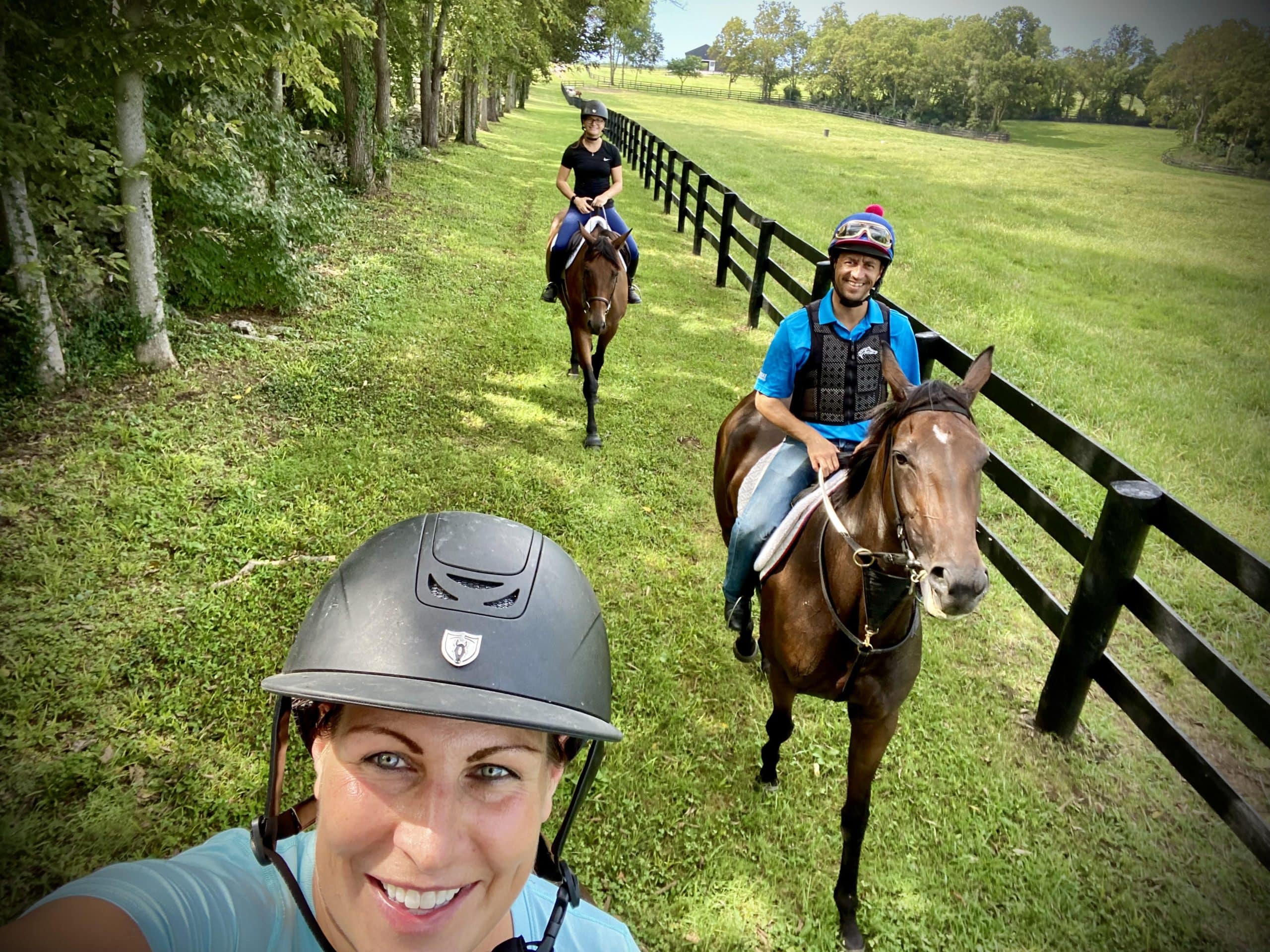
Jen Roytz, former jockey David Meah (on Fiddle) and trainer Anna Meah take a ride around Brownstead Farm. Courtesy Jen Roytz
Farms with training facilities and a track allow a horse to remain in light training if that’s what the trainer wants and the horse’s physical condition permits. For example, if a horse strained a muscle, he might spend some time on stall rest and receive therapeutic treatments. The trainer could then ask the farm to give the horse some gallops on the training track before returning to the racetrack, or the trainer could opt to bring the horse back to the track and oversee that transition personally.
Whether horses travel for a vacation depends on geography. In California and New York, for instance, racetracks are located near urban areas, where land is scarce and expensive. Racetracks might not have the same therapeutic resources available that a farm does, meaning horses must travel to access them.
Places such as Fair Hill Training Center, in Maryland, on the other hand, can offer an array of services that mean a horse never has to leave except to race. Fair Hill has 350 acres that include dirt, synthetic and turf tracks, cross-country terrain for hacking and turnout paddocks.
Graham Motion trained Brownstead runner Drakesboro Wildcat (Get Stormy — Gogo Jojo, Johar) at Fair Hill, so that gelding came home less frequently between races.
“He could get turnout, and they have the ability to hack the horses out into the fields,” Roytz says. “When he was in a more traditional racetrack environment, he came home more regularly, as he would get too keen.”
Another advantage to a farm is personnel can often ride horses in different equipment. Some layup farm staff have gone so far as to ride horses in Western saddles if that helps them relax, though often it’s as simple as using a different bit.
When Drakesboro Wildcat would come to Brownstead, Roytz used a bit with more leverage than the snaffle bits racehorses usually race and train in.
“A lot of what we worked on when Drake would come home were half-halts, serpentines and trot and canter pole exercises,” Roytz says. “Those changes of pace and direction helped him to be more balanced and not as heavy on his front end and made him more rideable once he went back to the track. He retired last year and is now using those foundational lessons in the show ring with his teenaged owner.”
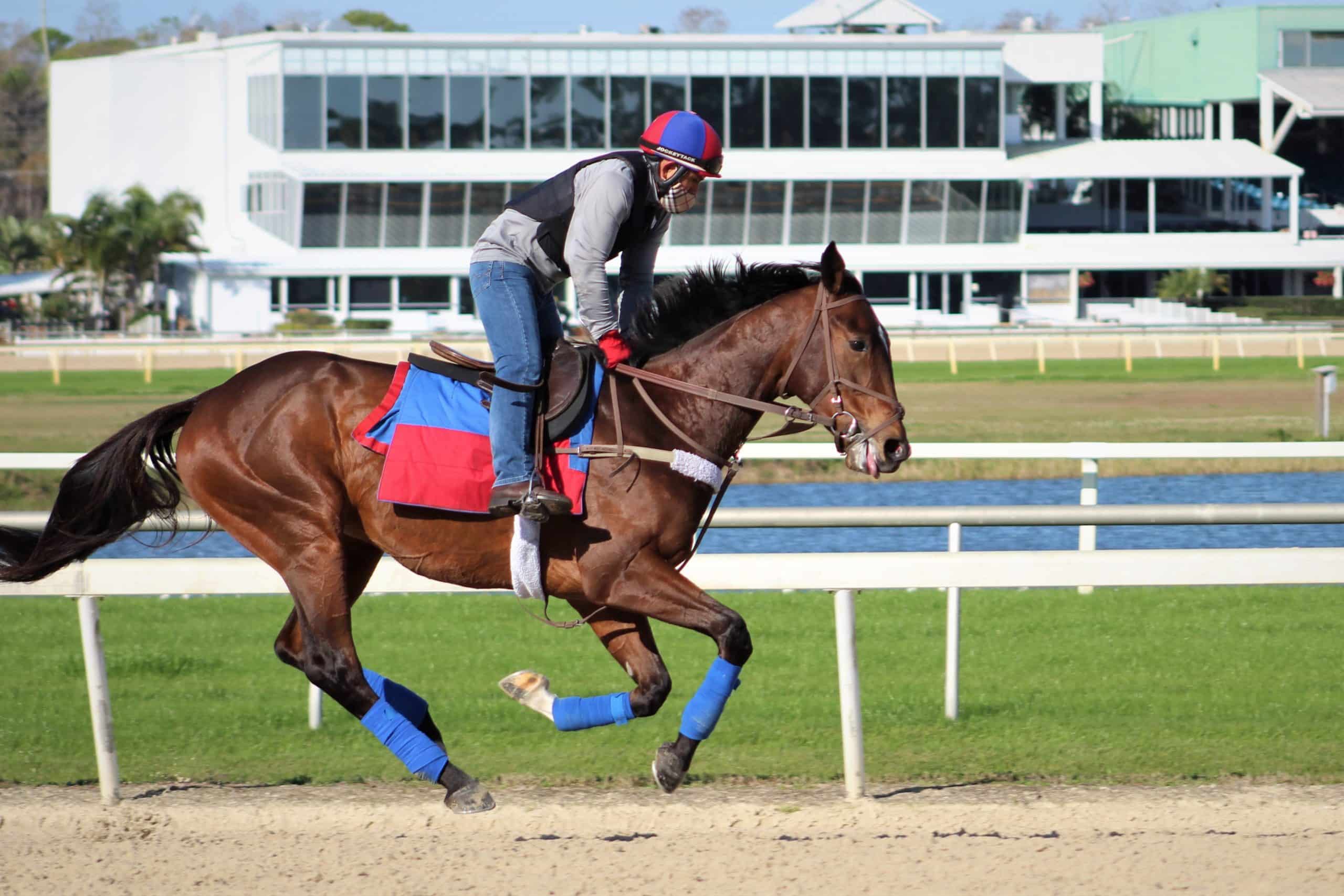
Drakesboro Wildcat learned foundational lessons at home between races that are now paying off in the show ring with his new owner, Haley Brockman. Courtesy Jen Roytz
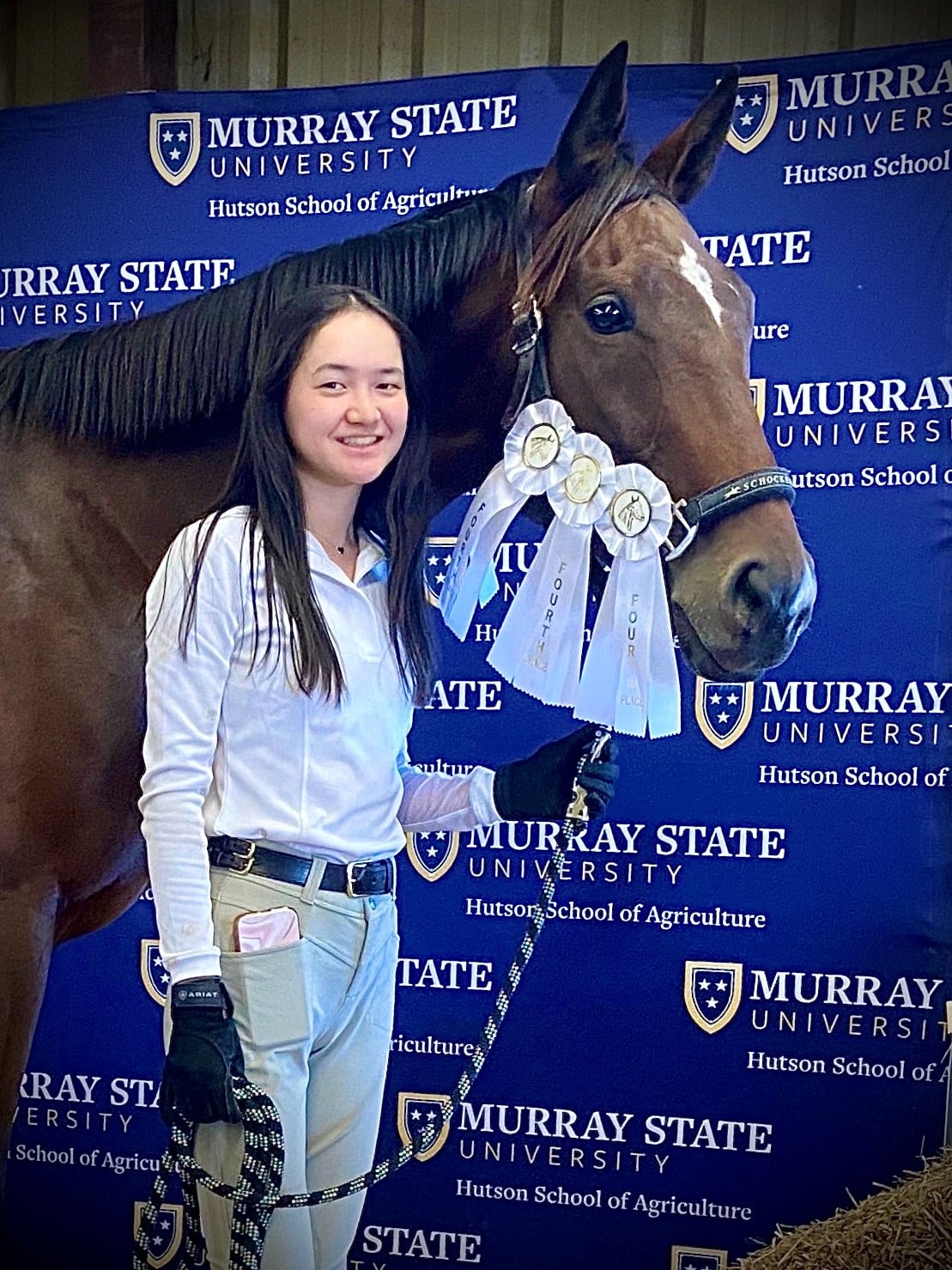
Roytz recommends the value of hacking a horse and doing something completely different from racetrack training.
“They’re just so much looser physically, through their shoulder and hip and back,” she says. “Their walk is just a little bit looser, and their trot is a little bit more extended.”
Older racehorses might benefit from farm vacations even more than young horses.
“Sometimes those are the horses that overexert themselves, are more prone to gastrointestinal issues or get stiff after a race,” Roytz says. “To be able to send them to a place where they are constantly grazing and constantly moving around is great for their physical recovery and fantastic for their minds.”

